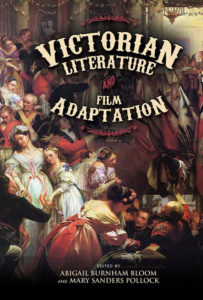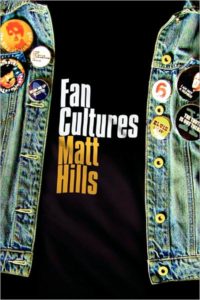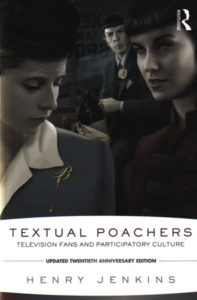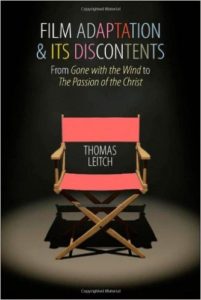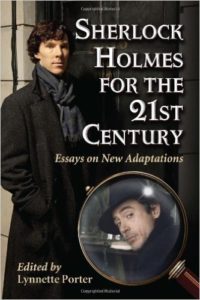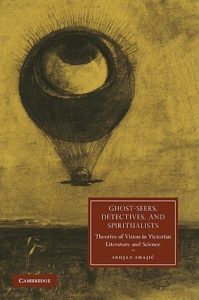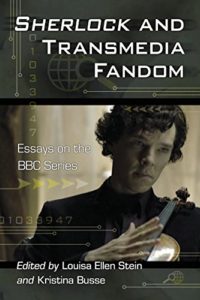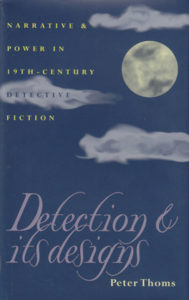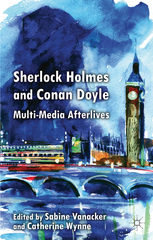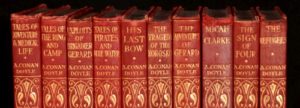
1.Bloom, Abigail Burnham and Mary Sanders Pollock (Eds.) Victorian Literature and Film Adaptation. Amherst, NY: Cambria Press, 2011. Print
Bloom and Pollock argue that the preconceived “canon and image of Victorian fiction” needs to be widened (8). They divide their book into three sections: Reinterpreting the Victorians: Adaptation and the Techne of Revision, Modifying the Victorians: Adaptation and Shifts in Cultural Values and Translating the Victorians: Teaching Books by Reading Movies. Leitch suggests that the study of adaptations offers a better understanding of literature (16). Leitch proposes that students use Rose’s adaptive model to view adaptations via “tracer text” (38). Rose defines “tracer text” as stories with “archetypical” themes that cultures have adapted over time periods (38). Leitch lays out four models of adaptation: “sunburst, genealogy, daisy chain, and tracer-text” (43). Leitch defines intertextuality as the relationship between the source text and the adaptation (43). This concept is further discussed by other contributing authors. Moody argues the transposition of text illuminates the author’s “transformed presence” (169).
This analysis between source text and adaptations provides new interpretations of adaptations. Leitch discusses how adaptations reflect their generation as well as the source material. The novel’s argument about Victorian literature, adaptations, and intertextuality expands authorship from when the text was created to include the master puppeteers pulling the strings of influence in the productions of the adaptations. Wagner argues that removing characters from their source texts and placing them in different space and times broadens their character development (207). These arguments and illustrations generate new questions about the influences of the time period that an adaptation was made in concert with the source text.
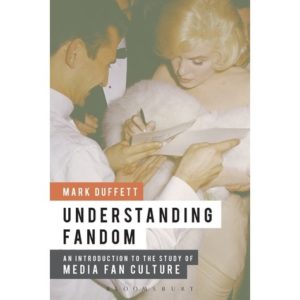 2. Duffett, Mark. Understanding Fandom: An Introduction to the Study of Media Fan Culture. New York: Bloomsbury Publishing Academic Press, 2013. Print
2. Duffett, Mark. Understanding Fandom: An Introduction to the Study of Media Fan Culture. New York: Bloomsbury Publishing Academic Press, 2013. Print
Duffet offers a generalized overview of fandom, its definition, and explores what it means to be a fan. He reviews themes such as consumerism, identification, and performance. He discusses the practice of “othering” fans which places certain fans as a group outside mainstream society (37). Duffet explores Fiske’s ideas about fans and their relationship to text where the fans become both the consumer and the producer (63). He reviews Cornel Sandvoss’s theory for media fandom. The theory argues the fan’s “experience of intimacy” with the object “frames” their fandom experience (115). Sandvoss views the “fan objects” as a “projection” of their identity to the greater community (115). Duffett defines “meta-text” as a mixture of “primary text” and a compilation of “secondary text” which reference it (215). The textual meaning is not derived from the source text but reconfigured “by-products” to the text (215). Duffett argues that these “paratexts” fail when the narrative is told across mediums and media (215).
Duffet’s discussion on fan fiction, slash fan fiction and the fan’s identification with the narrative is useful when examining the Sherlockian fandom. His chapter on Myth, Cults, and places where he discusses meta-text is relevant to the project in the discussion of the transformation of Doyle’s signs. The meta-text discussion is relevant to my project as the project examines the early Holmes illustrations by Paget and how visually those illustrations alongside Gillette’s performance of Sherlock because a source text of their own to the Sherlock mythology.
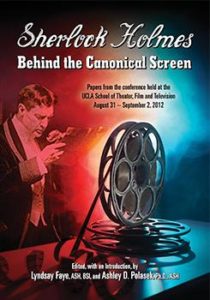 3. Faye, Lyndsay and Ashley D. Polasek (Eds.). Sherlock Holmes: Behind the Canonical Screen (Papers from the conference held at the UCLA School of Theater, Film and Television August 31-September 2,2012). The Baker Street Irregulars. 2015. Print (non-academic/secondary)
3. Faye, Lyndsay and Ashley D. Polasek (Eds.). Sherlock Holmes: Behind the Canonical Screen (Papers from the conference held at the UCLA School of Theater, Film and Television August 31-September 2,2012). The Baker Street Irregulars. 2015. Print (non-academic/secondary)
Faye and Polasek serve as editors over a compilation of papers on Sherlock Holmes. They analyze the screen adaptations in relation to the Doyle Canon. The first section discusses Sherlockian “histories and early cinema” and the character Sherlock Holmes arc of development. The second and third section examines specific Sherlockian case studies and the “production adaptations” (xii). The cinema spans silent film to Sherlockian musicals and cartoons. Polasek and Faye contribute essays that examine the female’s role within Sir Arthur Conan Doyle’s Canon and the film adaptations (xii). The last section deals with transcripts from question and answer sessions with writers, directors and production designers from the latest Sherlock adaptations (xiii). Polasek and Faye argue that “fans shape this world of ours, both subtly, and unsubtly, and fans are shaped by adaptations” (xiv).
The book’s argument is on the cinema adaptations compared to the Doyle Canon. The overview of the early cinema and histories show how Gillette’s play adaptation and Paget’s illustrations have been propagated into the Holmes mythology.
The discussion of the Rathbone and Granada cinema adaptations are pertinent to my research in the similarities and differences between Doyle’s Canon and the adaptations. The Rathbone, Brett, and Cumberbatch discussions show how each actor has transformed the Holmes character. Also, how they compare to the Canon, the iconographic images of Holmes with the hat and pipe, and their cinema transformation. The information utilized with the other research shows and corroborates the origin of the iconic imagery of the detective and how it differs from Doyle’s text.
4. Frankel, Valerie Estelle. Sherlock: Every Canon Reference You May Have Missed in BBC’s Series 1-3 LitCrit Press January 16, 2014. Print
Frankel examines BBC’s Sherlock Season One against the Holmes Canonical stories. Frankel explores where Moffat and Gatiss, the Sherlock producers and writers, paid homage to Doyle. Frankel reviews each episode of the first season from title, story, symbolism, and blog, canon references to pop culture, innuendo, locations, actor allusions, and Doctor Who. She uses production notes and quotes from “Watson’s Blog”. The BBC show created the blog as a modernization of the journal that Watson wrote about his adventures with Sherlock Holmes. She examines the characters, Sherlock Holmes, John Watson, Mycroft Holmes, Jim Moriarty, Charles Augustus Magnussen, Mary Morstan, Mrs. Hudson, Molly Hooper, and Greg Lestrade in relation to the canon. Frankel argues that the BBC series “redefined Sherlock Holmes” and his “fandom” (183). The BBC adaptation brought new fans into the fandom through its telling and the popularity of actor, Benedict Cumberbatch.
The book provides insight between the Holmes Canon and the BBC version. Her discussion on the stories; “A Study in Scarlet, The Hound of the Baskervilles, and The Final Problem” provides useful references for my project to show the transformation. The latter chapters on the characters were disappointing as it focuses more on Moffat and Gatiss production notes such as costuming decisions. Additionally, Frankel suggests Holmes is autistic but his argument is that the adaptation defines Holmes as a sociopath. The book acts as a guide with the source material and the BBC adaptation.
5. Hills, Matthew. Fan Cultures (Sussex Studies in Culture and Communication) Routledge Press, 2002. Print
Matthew Hills explores fan communities and the moral dualism found between the fan identity and the academic-scholar fan. He defines “imagined subjectivities” as the communities that are divided into an “us” versus “them” mentality (21). The “scholar-fan” faces criticism from both the academic and fan community for not fitting into either category. The “scholar-fan” are outsiders to the academic community and to the fan community who do no consider them “real fans” (21). Hills discusses Adorno’s concept of “the dialectic of value”. The concept demonstrates how fans reside both “inside and outside” the fandom commodity while they assign “personal value” to their “object within the fandom” (44). Hills argue Fiske and Thornton’s perspective is mired by their profession as an academic-scholar fan rather than a fan-scholar (63). He examines the cult aspect of fan communities and how the communities take on a religiosity which allows the individual fan freedom in their actions (129). Fans become engrossed in their fan activities similar to a cult experience. The cult status allows fans to contribute to an “endless deferred narrative” by “poaching” text (143). Additionally, Hills examines “fan ethnographies” where they only address “single texts or narrow intertextual networks” that are organic (89). Hills discussion of the moral dualism between the academic-scholar-fan and the fan shows their relationship to fan culture theories.
The book provides a survey of the arguments with their accompanying theories that surround fan cultures and communities. Although, not directly related to the Sherlock research it offers an evaluation of the role of fan communities and academics with the source text.
The chapters, “Between Cult and Culture” and “Between ‘Textual’ and ‘Extratextual’” are relevant to my research in his discussion between the iconography, fan communities, and the “poaching” of the text.
6. Jenkins, Henry. Textual Poachers: Television Fans and Participatory Culture. Routledge Press, 2012. Print.
Jenkins examines media fandom through Michel de Certeau’s “poaching” model where the fans usurp the original text. Jenkins defines “poaching” theory as “the relationship between readers and writers” as they appropriate the text (24). This relationship produces a plethora of meanings to the text. Thus, a battle wages between the fans and the authors for the established meanings in the text (33). Jenkins argues media fandom textual production is shaped by the community and resources of the larger community (49). Jenkins states de Certeau’s model shows that fans are captivated not with the origin text but the materials that they have created from their poaching (63). Jenkins uses as an example the fandom relationship between the Beauty and the Beast television series and their adaptation choices. He argues that fans are creators through the “poaching” to propagate their given community.
The book provides an overview of de Certeau’s model and fan interactions as a community through art, pastiche, online communities. The discussion on how text is read, fans appropriation of the text creates new narratives, slash, and gender makeup within the fan communities are relevant to my project.
Overall, the book provides theoretical background into media fandom and different aspects of a fan and their respective community. This book provides on the interaction between readers and text. The interaction and appropriation of the text to create new meanings will be relevant to my studies. As my project examines Sherlock Holmes and the Holmesian adaptations, this book’s arguments about the fan community can be applied to the Sherlockian fandom in relation to their source text.
7. Leitch, Thomas. Film Adaptation and its Discontents: From Gone with the Wind to the Passion of the Christ. Baltimore, John Hopkins University Press, 2007. Print
Leitch argues adaptation places reading over writing (3). Leitch reviews Hirsh’s argument that contemporary students are less knowledgeable of literature than their forbearers. Thus, these students lack understanding of the intertextuality found between a source text and its adaptations (7). Leitch argues “…whether it is possible to distinguish between adaptation and allusion or to construct a systematic grammar of intermediate modes between these two kinds of intertextual reference “(20). He proposes intertextuality relationships cut across many adaptations. He claims when the adaptation was created influences and informs that adaptation. Also, he questions what occurs when the adaptations become a textual source (302).
Leitch argues Sherlock Holmes provides insight into the Holmes iconography and how it differs from the source text. The book’s analysis of these Holmes images and their relationship with the adaptations are beneficial. For an example the illustrator Paget and how in drawing Holmes that he rejected Doyle’s description (209). Additionally, Leitch examines the pipe and statement, “Elementary, my dear Watson” which are both associated with Sherlock Holmes. He examines their origin with the American actor, William Gillette who portrayed Sherlock Holmes in 1899 in a play titled, Sherlock Holmes, based upon Doyle’s stories (209).
Leitch’s analysis fits into my argument as to how the original source text “signs” have been transformed by the adaptations. His studies historical data into the origins of the iconography.
8. Porter, Lynnette (Eds.). Sherlock Holmes for the 21st Century: Essays on New Adaptations. Jefferson, North Carolina, and London. McFarland and Company, Inc. Publishers. 2012. Web (Google books)
Porter explores the new twentieth and twenty-first adaptations of Sherlock Holmes and their “resurgence in popularity” (10-13). The character’s popularity growth was brought by the BBC Series, Sherlock (2010) (13). The Baker Street Irregulars founded in 1934 and the 1951 Sherlock Holmes Society of London fans desire to be part of Sherlock’s great game (12-13). Porter concludes that Holmes and Watson are timeless characters that have captured “our imagination” (208).
The book provides insight into the characters of Sherlock Holmes and Dr. John Watson, and their relationship. Bochman analyzes how BBC utilizes new technology (152). Graham and Garlen’s essay explores Sherlock Holmes as a sex symbol and how it differs from Doyle’s original vision of the character (31). Toadvine explores the character Dr. John Watson as depicted in the new adaptations. Additionally, Taylor alludes to how the new adaptations still hold the “trappings” of Doyle’s Holmes (101). These arguments provide support the examination of the characters, Sherlock and Watson. It provides background into the BBC version which I am exploring in my argument.
9. Smajic, Srdjan. Ghost-Seers, Detectives, and Spiritualists: Theories of Vision in Victorian Literature and Science (Cambridge Studies in Nineteenth-Century Literature and Culture). Cambridge: Cambridge University Press, 2013. Print
Smajic proposes ghost-seeing within Victorian literature as contextual (4). Smajic uses the scientific discourses from Brewster, Carlyle, and Ruskin as they relate to the Victorian ghost and detective fiction written by Poe, Dickens, and Doyle. Smajic demonstrates the systematic change from the optical “vision” to the reader-interpreter intuitive vision. Smajic discusses the interplay “between vision and knowledge” (17). Smajic follows Jonathan Crary’s argument from Techniques of the Observer (1992) where vision moves from the physical optical as represented previously by the camera obscura to the “physiological aspects” of intuition (18, 19). He argues that Poe, Collins, and Doyle are the interpreters of the “vision” within “the work of detection”. The vision is pursuant to the underlying truth behind the criminal act (6). Lastly, he examines “occult detective fiction” and it’s blending of intuition and observation (8).
The discussion of semiotics and signifiers within nineteenth-century fiction shows how context, content, and clues are found in detective novels language. Doyle’s novel, A Study in Scarlet (1887) shows the character, Holmes, as a “seer” within the work of deduction. As a “seer” Holmes puts his knowledge to work in his examination of the crime scene.
Evaluating the novel in relation to my project show how the use visionary language informs how the “signs” reflect the Victorian age.
10. Stein, Louisa Ellen and Kristina Busse (Eds.). Sherlock and Transmedia Fandom: Essays on the BBC Series. Jefferson, NC: McFarland and Company, Inc. 2012. Print
Stein and Busse explores the intersection between transmedia and fandoms. They focus specifically on the BBC Sherlock adaptation (2010), its relationship with the Sherlockian canon and fandom within digital culture (9). The essays discuss the character, Sherlock Holmes, at various “cultural and representational” intersections (10). Doyle’s novels and short stories which comprise the Sherlock Holmes canon are considered transmedia text. The ownership and remediation of the characters, Sherlock Holmes and Dr. John Watson are examined through “paratexts and intertexts” (18). Additionally, the essays examine how Doyle’s Holmes has translated into modern day from Victorian England. The book provides a discussion as to whom in the Sherlockian fandom is considered “official” and how these fans participate in the game. The fans’ participation in the “game” transforms the transmedia text through their engagement. Hills and Polasek argue this has occurred with the BBC’s adaptation. Transmedia text defines the relationship between digital fandom and the fans ‘production of pastiches and novels. Although, not an academic book, the focus of the character Sherlock Holmes and Doyle’s original text is pertinent as this project examines the changes that have occurred. From the relationship between Sherlock and Watson to the modern interpretations of the characters and text.
11. Thoms, Peter. Detection and its designs: Narrative and power in 19th century detective fiction. Athens, OH: Ohio University Press, 1998. Print
Thoms argues the detective becomes a narrative device with to share the story within the story of the crime to the audience (1). The author argues the detective assumes an “authorial figure” role where he “exerts” that power over the relationships similar to the criminal that he is pursuing. The narrative to solve the crime becomes a game as “…he reduces characters to game pieces to be manipulated on a playing board; he proceeds on the premise that mystery represents a puzzle to be solved and a victory to be won.” (2). the game and pieces aspect fit succinctly with Doyle’s Sherlock Holmes character. Thom’s explores these aspects within the fictional worlds created by the authors, Edgar Allen Poe, Charles Dickens, Wilkie Collins, and Sir Arthur Conan Doyle. Thoms argues, “…they expose story as a construction, inviting a kind of reading that counters the interpretive work of the detective, undoes his assertions of power, and turns us back again to the mystery” (8). Sherlock Holmes and Dr. Watson within their story narratives epitomize Thom’s argument of the powerful figure controlling relationships and the narrative’s direction. He concludes that reader and Dr. Watson consent to submission and “responsibility” within the story’s construction (150).
The book’s argument uses stories by Poe, Dickens, Collins, and Doyle as case studies that demonstrate the centrality of the detective figure within the narrative. The figure’s power over the other character and story shows how he drives the narrative towards a conclusion.
Thom’s argument is relevant to my project as it informs about the central role of o Sherlock Holmes and his relationship with Dr. John Watson This power and authorial relationship changes between Holmes and Watson and Holmes and the other characters changes as the stories are adapted.
12. Vanacker, S. Sherlock Holmes and Conan Doyle: Multi-Media Afterlives. Palgrave Macmillan Publisher, 2012. Print
Vanacker and Wynne examine the media appropriations and adaptations that surround the Sherlockian phenomena. The essays address Doyle’s biographical and fictional afterlife, Holmes’ pastiche and feminist revisionist fan fiction, and how Sherlock Holmes has transformed across the media adaptations, Sherlock’s status as a cultural icon, McCaw’s analysis of the Granada series and the adaptation process in the 1980s, Cumberbatch’s modern Sherlock, and the interrelationship between the detective narrative, Doyle, and the Victorian world. They argue Sherlock Holmes as a “neo-Victorian” status and address Paget’s influence upon the character’s iconography (3). Paget’s brother served as the model for Sherlock which modified “Doyle’s uglier conception” of the character (3). The authors’ address Doyle’s recent resurrection as a fictional character alongside his own creation.
The book gives insight to various perspectives surrounding my project. O’Brien demonstrates how the cinema portrayal is a shadow of Doyle’s original text and that Holmes as an idea has evolved through the adaptations. The essays provide insight to the cinema adaptations while the neo-Victorian aspect shows background into the morphed signifiers. The authors touch on the Doyle stories, A Study in Scarlet, the Hound of the Baskervilles, and the Final Problem which are on as part of the project.
